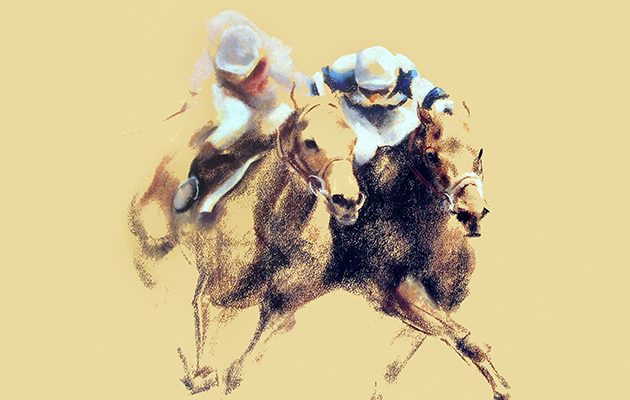Thanks to an encounter at Cheltenham, the work of John Skeaping has become accessible to a wider audience, as Janet Menzies explains
As Janet Menzies discovers, a chance encounter at Cheltenham has seen the work of John Skeaping become accessible to a wider audience.
For more sporting art, Tristram Lewis swapped paintbrush for Plasticine to immortalise a great racehorse in bronze. And Zaza Shelley’s hallmark is meticulous preparation.
JOHN SKEAPING
Artists should lead unusual lives, it’s part of the job description, and the world of racing too is all the more beguiling because it is so, well, racy. When an artist is living and depicting horse and dog racing, sparks fly. John Skeaping and his first wife, Barbara Hepworth, were art’s golden couple in the 1920s. He was handsome and talented, producing dramatic sculpture and painting, notably a series of art deco animals for Wedgwood. She was beautiful and fêted.
By 1931 their marriage was over; soon after, Skeaping became an intelligence officer in the SAS during the Second World War. And this is really where our story begins. Peter O’Sullevan, later to be knighted as a horse-racing commentator, was not passed fit for action overseas and so had to serve on the home front in London. A greyhound trainer at Stamford Bridge (then more famous for dogs than football) contacted O’Sullevan to tell him of a good dog down in Devon. “The owner’s going to serve overseas, so the dog needs a home but he won’t let it go until he’s spoken to whoever will have it, otherwise I think they’ll put it down.”
O’Sullevan’s response was swift: “For God’s sake, ring him up before it’s too late.” The greyhound’s owner was John Skeaping, the dog was called Slim and so began a lifelong friendship. While Skeaping was sinking in a boat, sketching his brothers in arms as they waited for the ship to go down, O’Sullevan was putting out the home fires during the Blitz and, crucially, supervising the training of Slim.
John Skeaping survived the war and from then until his death in 1980, the two men went to the dogs – literally and, occasionally, metaphorically. Once, seeking a consolatory fish and chips having suffered a bad night at White City dog track, they conducted an inventory of their finances. Skeaping’s liquid assets amounted to 16 shillings; O’Sullevan’s a slightly more healthy £18. “I’ll sell you that series of greyhound pictures for a tenner,” proposed Skeaping and, in the tradition of Van Gogh and so many before and since, art and chips changed places and both men went on to achieve great things.
O’Sullevan would be knighted for his services to racing. Skeaping became professor of sculpture at the Royal College of Art, until moving to the Camargue in the 1960s. This was when he produced much of his best work, both on canvas and sculpture. His life-size studies of racehorses Hyperion, Chamossaire and Brigadier Gerard are magnificent. He exhibited all over the world and developed a fluidity and economy of line that captures the essence of animal movement. He explained: “Dramatic emphasis can only be accomplished by exaggeration and/or elimination.”
But what became of the greyhound studies? At this point, gallery owner and art commissioner David Fish, of Conversation Pieces, enters the story. Fish explains: “We’ve had a gallery at Cheltenham Races for many years, which is how I bumped into Sir Peter. He invited me to go to his flat in Chelsea to look at his Skeapings. I confess, I didn’t really know very much about Skeaping at that point but when I saw his work I was captivated. His picture The Finish was so simple but so full of the movement and passion of racing.”
Fish approached O’Sullevan to ask if he could publish the picture as a limited-edition print. With typical generosity, the reply was: “The picture has given me so much enjoyment, it would be great for other people to be able to share that.” This fitted in perfectly with Fish’s idea of the Conversation Pieces gallery, which aims to bring sporting art to everybody by producing highly collectible limited-edition prints, often specially commissioned. “I want people to be able to get involved in owning and collecting equestrian art without having to have a huge budget. And the story behind a painting is really important to me.”
As their friendship developed, Fish and O’Sullevan found themselves rummaging around in a cupboard at the Chelsea flat. “I’m sure that greyhound study is here somewhere,” said O’Sullevan. Eventually they dug it out and Fish has been able to publish the print. If ever a picture tells a story, this one truly is worth a thousand words.
John Skeaping’s work can be seen at the Tate in London, and other major galleries. He is published at the Conversation Pieces gallery, www.ascotgallery.com. Original sculptures and paintings occasionally come up for sale.





